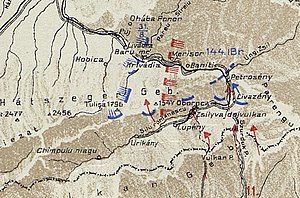Petrozsény Offensive
| Petrozsény Offensive | |||||||
|---|---|---|---|---|---|---|---|
| Part of the Battle of Transylvania of the Romanian Campaign of World War I | |||||||
 | |||||||
| |||||||
| Belligerents | |||||||
|
|
| ||||||
| Commanders and leaders | |||||||
|
|
| ||||||
| Units involved | |||||||
|
| ||||||
| Casualties and losses | |||||||
| Unknown | Unknown, but heavy | ||||||
The Petrozsény Offensive was the opening action of the south-western front of the 1916 Battle of Transylvania, during World War I. The Transylvanian coal-mining center of Petrozsény (Petroșani) was occupied by the Romanian Army on 29 August, two days after the Kingdom of Romania declared war on Austria-Hungary.
Background
Romania declared war on Austria-Hungary on 27 August 1916.[1] The central column of General Ioan Culcer's Romanian 1st Army advanced into a region of valuable coal mines, whose output was crucial to the Hungarian railway system.[2] The Romanian advance was opposed by the Austro-Hungarian 1st Army, under General Arthur Arz von Straußenburg.[3]
Romanian offensive
The Romanian forces occupied Petrozsény on 29 August.[4][5][6] The Jiu Covering Force, consisting of the 21st Infantry Brigade of the 11th Division, crossed the border at the Vulkán and Szurdok passes and occupied the vital Transylvanian coal-mining center at Petrozsény on 29 August. The weak resistance put up by the Hungarian coal-miner battalions was easily swept aside by the Romanian units, who inflicted heavy casualties. The rest of the 11th Division (General Ioan Muică) subsequently crossed the mountains and joined the covering forces. It then pushed further west, stopping 15 miles from Hátszeg (Hațeg). Although this halt complied with the instructions received by Culcer, it allowed the Austro-Hungarians time to regroup and would have great repercussions later.[7] By 3 September, this group of General Culcer's Romanian 1st Army occupied the important coal area between Hobicaurikány (Uricani) and Petrozsény, driving back the ineffective Landsturm and miners battalions of the 144th Infantry Brigade over the saddle of Merisor.[8] On 29 August, fighting also took place against the 144th Brigade at Zsilyvajdejvulkán (Vulcan),[9] with further fighting taking place at Mount Oboroca on the 30th.[10] The commander of the 144th Brigade was Colonel Ludwig Berger.[11]
Aftermath
Due to its valuable coalmines, the area occupied by the center of General Culcer's 1st Army was the first location of any military or commercial value to fall into Romanian hands. As such, this was also the scene of the first Central Powers counterattack against the Romanian invasion of Transylvania, on 8 September. However, the Romanian troops had little difficulty repulsing this attack.[12]
References
- ^ Michael B. Barrett, Indiana University Press, Oct 23, 2013, Prelude to Blitzkrieg: The 1916 Austro-German Campaign in Romania, pp. 1-2
- ^ Prit Buttar, Bloomsbury Publishing, Sep 22, 2016, Russia's Last Gasp: The Eastern Front 1916–17, p. 322
- ^ Michael B. Barrett, Indiana University Press, Oct 23, 2013, Prelude to Blitzkrieg: The 1916 Austro-German Campaign in Romania, p. 4
- ^ Erich Ludendorff, Harper & brothers, 1919, Ludendorff's own story, Volume 1, p. 293
- ^ John Buchan, T. Nelson, 1922, A History of the Great War: From the battle of Verdun to the third battle of Ypres, p. 227
- ^ Army War College (U.S.), U.S. Infantry Association, 1923, Campaigns of the World War, p. 106
- ^ Michael B. Barrett, Indiana University Press, Oct 23, 2013, Prelude to Blitzkrieg: The 1916 Austro-German Campaign in Romania, p. 22
- ^ Encyclopædia britannica Company, Limited, 1922, The Encyclopædia Britannica: The New Volumes, Constituting, in Combination with the Twenty-nine Volumes of the Eleventh Edition, the Twelfth Edition of that Work, and Also Supplying a New, Distinctive, and Independent Library of Reference Dealing with Events and Developments of the Period 1910 to 1921 Inclusive. The First-third of the New Volumes, Volume 30, pp. 914-915
- ^ Austria. Bundesministerium für Landesverteidigung, Verlag der Militärwissenschaftlichen Mitteilungen, 1930, Öesterreich-Ungarns letzter Krieg, 1914-1918, Volume 1, p. 95
- ^ Austria. Bundesministerium für Landesverteidigung, Verlag der Militärwissenschaftlichen Mitteilungen, 1930, Öesterreich-Ungarns letzter Krieg, 1914-1918, Volume 1, p. 93
- ^ Michael B. Barrett, Indiana University Press, Oct 23, 2013, Prelude to Blitzkrieg: The 1916 Austro-German Campaign in Romania, pp. 102 and 387
- ^ Prit Buttar, Bloomsbury Publishing, Sep 22, 2016, Russia's Last Gasp: The Eastern Front 1916–17, p. 322
